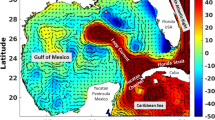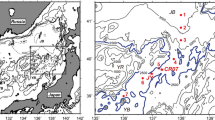Abstract
To investigate the impact of current variations of the Oyashio on bottom pressure (BP) at observation stations PG1 (\(41.7040^{\circ }\hbox {N}\), \(144.4375^{\circ }\hbox {E}\)) and PG2 (\(42.2365^{\circ }\hbox {N}\), \(144.8454^{\circ }\hbox {E}\)), which are located in the onshore region of the Kuril Trench off Kushiro–Tokachi, altimetric sea surface height (SSH) and ocean bottom pressure (OBP) gauge data were evaluated. Two and a half years after El Niño, during 2007–2008 and 2012–2013, the Oyashio retreated toward the northeast in association with strong warm-core rings, which were inferred from SSH elevations at both stations. BP at PG1 near the offshore edge of the continental shelf is enhanced corresponding to the SSH elevations in a barotropic manner. Meanwhile, at PG2, BP remained relatively unchanged in spite of the high SSH variability because the main pycnocline adjusted rapidly to the SSH elevations. BP changes at PG1 caused by the northeastward retreat of the Oyashio cannot be neglected to detect BP change by crustal deformations.




Similar content being viewed by others
Change history
24 November 2019
In the original publication, the Fig. 2 was published incorrectly. The correct version (Fig. 2) is given in this correction. The original article has been corrected.
References
AVISO (2008) SSALTO/DUACS user handbook: (M)SLA and (M)ADT near-real time and delayed time products. Technical report, CLS, Ramonville St Agnes
Cushman-Roisin B, Beckers JM (2011) Introduction to geophysical fluid dynamics, 2nd edn. Academic Press, New York
Emery WJ, Lee WG, Magaard L (1984) Geographic and seasonal distribution of Brunt-Väisälä frequency and Rossby radii in the North Pacific and North Atlantic. J Phys Oceanogr 14:294–317
Franco SI, Kostoglodov V, Larson KM, Manea VC, Manea M, Satiageo JA (2005) Propagation of the 2001–2002 silent earthquake and interplate coupling in the Oaxaca subduction zone, Mexico. Earth Planets Space 57:973–985. https://doi.org/10.1186/BF03351876
Gill AE (1982) Atmosphere-ocean dynamics. Academic Press, New York
Hasegawa T, Hanawa K (2003) Heat content variability related to ENSO events in the Pacific. J Phys Oceanogr 33:407–421
Hirose H, Obara K (2005) Repeating short- and long-term slow slip events with deep tremor activity around the Bungo channel region, southwest Japan. Earth Planets Space 57:961–972. https://doi.org/10.1186/BF03351875
Itoh S, Sugimoto T (2002) Behavior of warm-core rings in a double-gyre wind-driven ocean circulation model. J Oceanogr 58:651–660
Kawabe M (2000) Calculation of the interannual variations of sea level in the subtropical North Pacific. J Oceanogr 56:691–706
Kawaguchi K, Hirata K, Mikada H, Kaiho Y, Iwase R (2000) An expendable deep seafloor monitoring system for earthquake and tsunami observation network. In: 2000 MTS/IEEE conference 3, pp 1719–1722
Kuroda H, Wagawa T, Shimizu Y, Ito S, Kakehi S, Okunishi T, Ohno S, Kusaka A (2015) Interdecadal decrease of the Oyashio transport on the continental slope off the southeastern coast of Hokkaido, Japan. J Geophys Res 120(4):2504–2522. https://doi.org/10.1002/2014JC010402
McPhaden MJ, Zebiak SE, Glantz MH (2006) ENSO as an integrating concept in earth science. Science 314:1740–1745. https://doi.org/10.1126/science.1132588
Miyazaki S, Segall P, Fukuda J, Kato T (2004) Space time distribution of afterslip following the 2003 Tokachi-oki earthquake: implications for variations in fault zone frictional properties. Geophys Res Lett. https://doi.org/10.1029/2003GL019410
Munk WH (1950) On the wind-driven ocean circulation. J Meteor 7(2):79–93
Nagano A, Wakita M, Watanabe S (2016) Dichothermal layer deepening in relation with halocline depth change associated with northward shrinkage of North Pacific western subarctic gyre in early 2000s. Ocean Dyn 66(2):163–172. https://doi.org/10.1007/s10236-015-0917-8
Nagano A, Hasegawa T, Matsumoto H, Ariyoshi K (2018a) Bottom pressure change associated with the 2004–2005 large meander of the Kuroshio south of Japan. Ocean Dyn 68(7):847–865. https://doi.org/10.1007/s10236-018-1169-1
Nagano A, Yamashita Y, Hasegawa T, Ariyoshi K, Matsumoto H, Shinohara M (2018b) Characteristics of an atypical large-meander path of the Kuroshio current south of Japan formed in September 2017. Mar Geophys Res. https://doi.org/10.1007/s11001-018-9372-5
Nakata R, Hino H, Kuwatani T, Yoshioka S, Okada M, Hori T (2017) Discontinuous boundaries of slow slip events beneath the Bungo Channel, southwest Japan. Sci Rep 7(1):6129. https://doi.org/10.1038/s41598-017-06185-0
Nanayama F, Satake K, Furukawa R, Shimokawa K, Atwater BF, Shigeno K, Yamaki S (2003) Unusually large earthquakes inferred from tsunamis deposits along the Kuril trench. Nature 424:660–663
Nitani H (1972) Beginning of the Kuroshio. In: Stommel H, Yoshida K (eds) Kuroshio-its physical aspects. University of Tokyo Press, Tokyo, pp 129–163
Pedlosky J (1996) Ocean circulation theory. Springer, New York
Polster A, Fabian M, Villinger H (2009) Effective resolution and drift of Paroscientific pressure sensors derived from long-term seafloor measurements. Geochem Geophys Geosyst. https://doi.org/10.1029/2009GC002532
Press W, Teukolsky A, Vetterling W, Flannery B (1992) Numerical recipes in fortran 77: the art of scientific computing, 2nd edn. Cambridge University Press, Cambridge
Rio MH, Guinehut S, Larnicol G (2011) New CNES-CLS09 global mean dynamic topography computed from the combination of GRACE data, altimetry, and in situ meansurements. J Geophys Res. https://doi.org/10.1029/2010JC00650
Sekine Y (1999) Anomalous southward intrusions of the Oyashio east of Japan: 2. two-layer numerical model. J Geophys Res 104(C2):3049–3058. https://doi.org/10.1029/1998JC900044
Stommel H (1948) The westward intensification of wind-driven ocean currents. Trans Am Geophys Union 29:202–206
Talley LD, Pickard GL, Emery WJ, Swift JH (2011) Descriptive physical oceanography: an introduction, 6th edn. Elsevier, New York
Thompson R (1983) Low-pass filters to suppress inertial and tidal frequencies. J Phys Oceanogr 13:1077–1083
Trenberth KE (1997) The definition of El Niño. Bull Amer Meteor Soc 78:2771–2777
Trenberth KE, Hurrel JW (1994) Decadal atmosphere-ocean variations in the Pacific. Clim Dyn 9:303–319
Wallace JM, Gutzler DS (1981) Teleconnections in the geopotential height field during the Northern Hemisphere Winter. Mon Weather Rev 109:784–812
Watts DR, Kontoyiannis H (1990) Deep-ocean bottom pressure measurement: drift removal and performance. J Atmos Ocean Technol 7:296–306
Acknowledgements
The authors would like to thank Prof. D. Inazu (Tokyo University of Marine Science and Technology) and Dr. Y. Itoh (Kyoto Univerisity) for their insightful comments. The authors express gratitude to Ms. K. Taniguchi (JAMSTEC) for correcting the manuscript. Also, the authors are deeply grateful to the guest editor of this special issue and anonymous reviewers for helpful comments. This work was partly supported by the Japan Society for the Promotion of Science (JSPS), Grant-in-Aid for Scientific Research (15H04228, 15H02835, 17K05660).
Author information
Authors and Affiliations
Corresponding author
Additional information
Publisher's Note
Springer Nature remains neutral with regard to jurisdictional claims in published maps and institutional affiliations.
The original version of this article was revised: The Figure 2 is updated.
Rights and permissions
About this article
Cite this article
Hasegawa, T., Nagano, A., Matsumoto, H. et al. El Niño-related sea surface elevation and ocean bottom pressure enhancement associated with the retreat of the Oyashio southeast of Hokkaido, Japan. Mar Geophys Res 40, 505–512 (2019). https://doi.org/10.1007/s11001-019-09392-8
Received:
Accepted:
Published:
Issue Date:
DOI: https://doi.org/10.1007/s11001-019-09392-8




